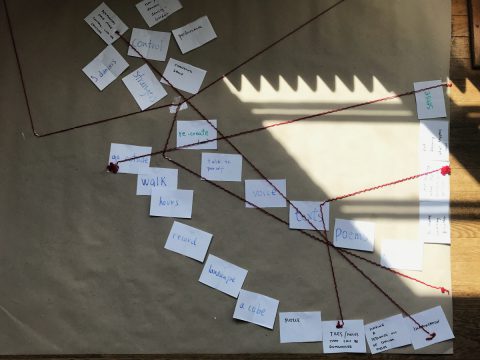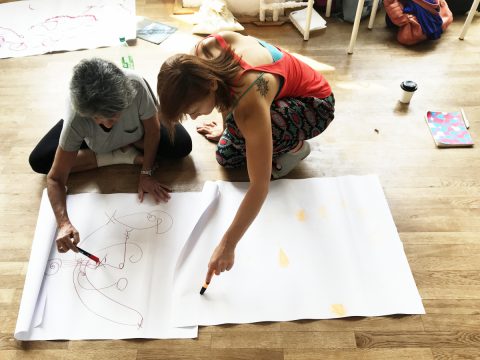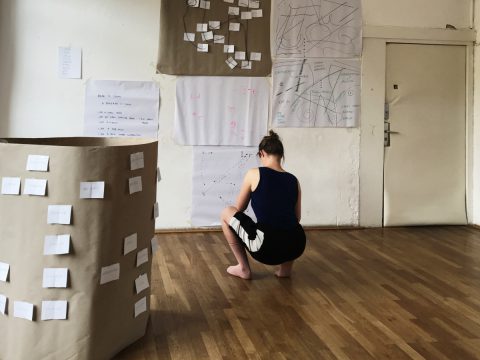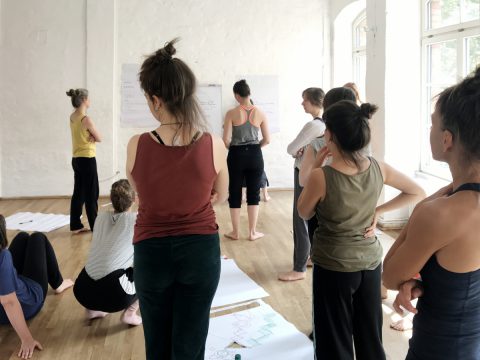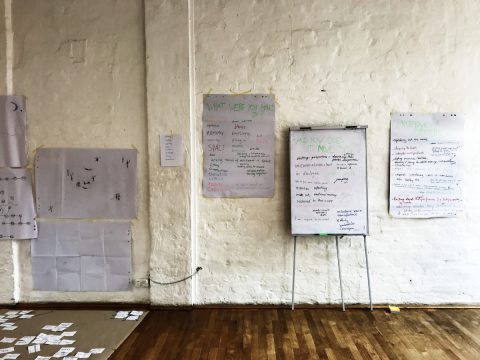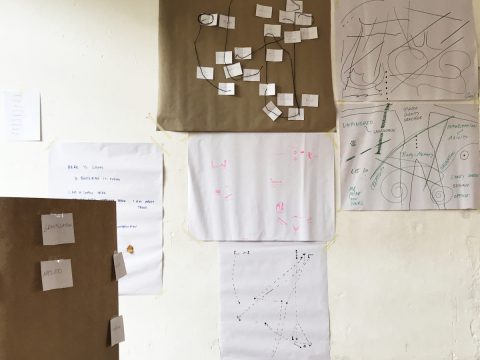In our process we repeatedly arrived at a point when we felt it was necessary to give our thinking some kind of materiality in (physical) space. Maps turned out to be rather immediate and productive. They created for us spaces for contemplation that we could physically follow. Working with maps as method produces a worldview that makes tangible the rich relational and spatial character of the object of research and allows exploring the complex and shifting entanglements of the various entities involved. The following are examples for mappings used in different situations and for various purposes.
The Alphabet
The Alphabet is a tool we developed together at the very beginning of Working Utopias. In our conversations, we found that there were recurrent concepts that we used in our respective fields to describe our project and the issues that were linked to it. We therefore started with developing the idea of an alphabet as a common place to engage with and understand each others’ ways of thinking, to store these concepts and ideas and to extend our working relationship. As a first attempt to build methods that are not exclusively determined by only one sphere to be able to deal with different kinds of knowledge, we conceptualized this alphabet in a non-linear way in that we produced it by means of a mapping exercise. Hence, instead of applying an alphabetical order, we used the space of a sheet of paper to place letters.
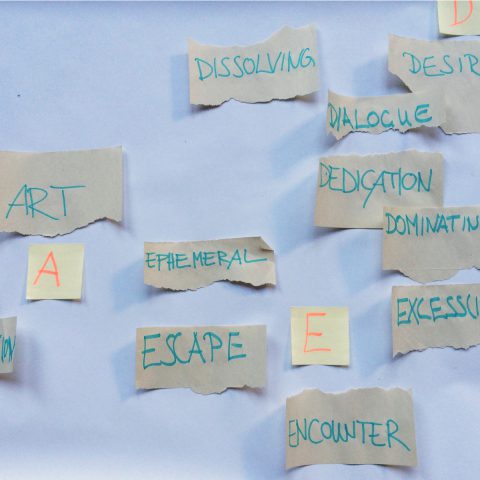
Part I: The alphabet as conversation tool:
Place a large sheet of paper in front of you; minimum size is 7 x 1,5 m so that you have move while mapping.
Think of terms you connect to the topic.
Alternate in writing down one term and place it on the sheet of paper.
If your term starts with a letter that has not been placed yet, choose a place for the letter first and then place your term.
Place every term in relation to the other terms already present.
Don´t talk!
Repeat it until both of you are empty of terms.
Take a moment / some time to walk around and look at the map from different perspectives.
Choose a term whose position, or relation to other terms interests, puzzles or dazzles you and interview the other about it.
Set the alarm clock to 5 min.
Record the conversation.
Next to using the alphabet as a conversation tool to engage with each others thinking, we also used the alphabet to develop a performative way of sharing this conversation with others.
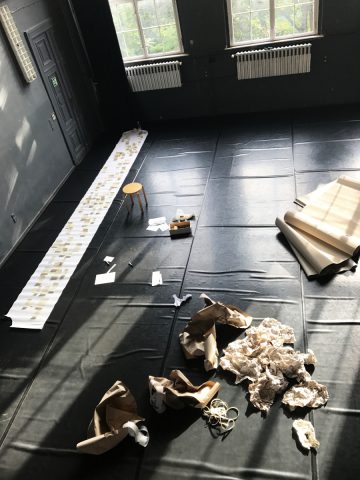
Part II: The alphabet as a performative structure
Place the alphabet in the room/ on the floor
Ask the people in the room to take a stool and come closer and to sit with you next to the alphabet
Choose elements of the alphabet and start a conversation
The following is exemplary for an alphabet-induced performative conversation that we performed in 2015.
A: Why Utopia?
A + C move to UTOPIA
C: In one of our first conversations we got fired up by the idea of Utopia. For me the main reason for being so drawn to the concept of utopia is that it is based on desire. And desire is what drives my artistic work – although I never considered it to be explicitly utopian before. After that conversation – when I was back home – I found books on my shelf about Utopia, which I borrowed from a friend long time ago. Unconsciously there seemed to be a relation to the topic for quite some time. In the course of our project I learned that not every nowhere can call itself utopia. To count as an UTOPIA, an imaginary place must be an expression of desire and that is when I realized that the topic is constitutively connected to my own practice.
A: I wanted to work with the notion of utopia for quite some time. I think it dates back to 2012 or so, because I was so sick of the “there is no alternative” politics that dominated the public opinion after the financial crisis that fuelled action through fear. So I wanted to look into another kind of force – a positive force – that motivates action.
In organisation studies, one can sense a similar longing as one can find more and more conferences but also publications that explicitly deal with alternative ways of organising. And to my surprise, organisation researchers use the concept of utopia. What I find interesting in the way this concept is used today is that it does not so much link with a comprehensive description of a perfect society – an aim that we have learned leads very quickly to totalitarianism – but more as a driving force. Valérie Fournier has also called it “movements of hope” to emphasize a notion of utopia that engages with what could be and not what is. This way, utopia is a highly productive concept and that is what makes it so interesting as it also allows considering utopianism an organisational matter.
C: In the field of art, Adorno has stressed that art is rooted in utopian thinking. Today however, this does not seem to be reflected but rather taken as naturally given. At the same time, it seems that there is a considerable increase in the use of the notion of Utopia in different contexts. It almost becomes a fashionable term and therefore is quickly emptied out. When it comes to ways of dealing with the notion of utopia that goes beyond some kind of aesthetic concept – it is often linked to experiments in the past – especially in the 1920s and 1960s – for example The exhibition on the Black Mountain College at Hamburger Bahnhof or Radically Modern at the Berlinische Galerie just to name a few. It shows that utopia is very much connected to an engagement with past utopias. The view is not on the present and future but back in history.
A: The notion of utopia has, next to this connotation of good place also the meaning of no place. I think this is crucial to emphasize, because a good place that at the same time is no-where initiates a different kind of movement. Instead of destroying what is, it creates an additional space, it goes lateral instead of directly replacing what is. It initiates developments that are not based on succession but fuelled by lateral movements that add instead of destroy.
A: What is work?
A + C move to WORK (pass behind the audience)
C: a personal question is for me: how sensible is it to draw the distinction between work and non-work? If you talk to artists it is difficult to make a distinction between work and life. In my own practice that refers more generally to ”Performance Art”, working relationships are often based on expertise as well as friendship. They often develop over time into personal relationships as well.
A: Oh, that is interesting, because then work becomes a means for integrating people into your life. And this is a totally different quality of the function of work, given the fact that work does not necessarily fulfill the exclusive function of obtaining financial resources anymore.
The question “what is work?” is constitutively connected with the question “what isn’t work?” But overall, this difference comes under threat – especially in creative/knowledge-intensive work. In my field this has been critically discussed under the notion of “Entgrenzung der Arbeit” (expansion of work into life).
C: But wouldn’t it be a kind of relief if one stopped thinking life in these categories but created a kind of overall “life-plan” – that is, a continuous flow and development – instead of steps (of career) that you reach and that become fixed entities in your life that cannot be changed anymore. It is a different way of thinking that does not create any fear of losing what you have reached; that would mean thinking life in motion instead of striving for particular goals.
A: That is also why we use the term work/lives to emphasize that there is not necessarily a duality anymore but that in some cases people do still distinguish between work and (private) life, whilst in other cases, this distinction is not made in form of a boundary but maybe in terms of intensities or maybe not at all.
C: Why do you interconnect work with utopia?
A: There are various new ways of working together under the conditions of radically individualized work/lives. However, there are different qualities of working together: collaboration, cooperation, complicity, gift or exchange, etc. and not everything can be considered a positive way of interacting with others. There is also a lot of parasite activity, theft, cannibalism…. we want to explicitly focus on how “good” work/lives (C moves to GOOD and A moves to HELL ) would look like and what kind of conditions they would have to display – without being so naïve, believing that alternative ways of organizing work-lives is not involved with power struggles and also without closing our eyes before the fact that every utopian ideal can also produce dystopian reality.
C:When I started working as a dancer I was very quickly unsatisfied with the working conditions of a dancer in larger groups. Soon I made the choice to work as an independent artist and started to build my own collaborative working structures based on intimate one to one relationships with only two to three people involved. When I think about my (artistic) practice, then this is constitutively connected to the people with whom I work.
The connection between work and utopia for me begins at this point and therefore I am interested in what kind of role utopian thinking plays on a broader perspective, in the development of alternative ways of organizing working and living together.
A : Is collaboration always a positive experience for you ?
C (looking at A sitting next to the term hell): I agree with you, Anke, that a collaboration also can turn into hell, in case the shared responsibilities are not delicately negotiated or economic pressure forces you to keep going even if you are exhausted and your creative resources are temporarily low. But this is exactly what makes this project so interesting from my perspective: it deals with this very delicate balance between individual freedom and mutual involvement; one could also call it a certain form of solidarity.
A: Talking of mutual involvement: Why you and me?
A + C move to opposite side of the alphabet
C: we both engage in a certain kind of utopian thinking in our respective fields, for instance when it comes to the definition of work. Whilst you are interested in alternative ways of organising, I engage with my work in questions of creating forms of temporary togetherness with an audience.
A: Yes, and I also found that the relationship with your work partners is also always part of your artistic work. So the form is also part the content, you could say. This considerably extends the “Werk” – the artwork with this additional dimension. Next to the fact that this artistic approach of you considerably influenced our way of working together I am also curious how this is going to be part of the results of our journey together.
I also find this project to be an opportunity for opening up social science research approaches for new ways of engaging, creating and dealing with different kinds of knowing. I always wanted to explore this zone of diffusion but I never dared to do it just by myself, because I felt it needed this exchange with someone who is experienced in this other field.
C (turns to the audience): we would like now to invite you once again to take your stool and join us on the side of the alphabet for a conversation that everyone can join.
Mapping a Poem
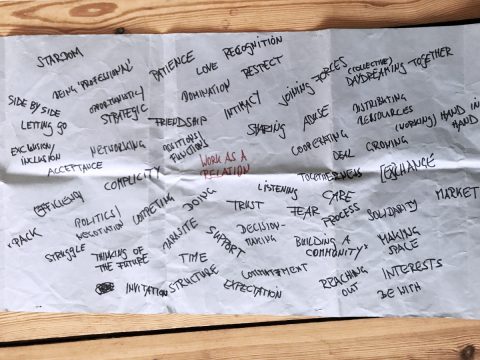
Thinking about work as a relation has interested us from the start, has accompanied us throughout different phases of the project and has evolved in various processes of thinking and developed with every new encounter that we had. At some point, we felt the need to materialise our thinking about this topic to get an overview over its complexity and rich ambiguity that it has taken on so far.
Like in other cases of mapping, we started to alternate in writing down terms – without talking – until we could not think of anything to add.
Mapping, here, allowed us to activate our memory and generate associations to think further. It enabled us to externalise our mutual thinking by materialising the elements of our thinking (in form of different terms) without pre-determining any order amongst them. It thus produces a kind of kinaesthetic space – a space that necessitates and facilitates continuous movement of thinking – in that it makes available the space between the terms for various different possibilities of statements/interpretation.
Maps allow a horizontal organisation of terms (in that they are all on the same plane) that resonates with the constant movements of thinking in contrast to a hierarchy of terms that thoughts entail.
Creating a map of work as a relation, thus, materialised a structure for further thinking about it. In this case the mapping was a tool for producing a text on Working Utopias and address the question of how to develop a language that allows art to fold into research and research into art.
Nowhere – Now Here
In the course of Tanzfabrik’s 40th anniversary that ran under the title “Remembering the Future” we were invited to run a lab and share some insights we gained in the course of our collaboration. We decided to pass on ‘mapping’ as a method of working that we have developed over the time to share or make visible different kinds of knowing that our respective fields of working are involved with. The following is a score (a set of directives intended to open up a space of engagement) of experimenting with maps of two days.
First day
1) Introduction of the project, showing different kinds of mappings
2) Forming pairs selected by chance
3) Ask them to go for a walk together (40 min) with each answering the other over 20 minutes the following question: how do you develop a new project/new question?
4) At the end of the walk write down on little pieces of paper terms that you remember from the other’s account as important for their way of developing new work.
5) Fold the pieces of paper and throw them into a common pot, where you mix what you remember with the terms that the other remembers of your account.
6) Take a big sheet of paper. Alternately draw the pot a piece of paper, read out loud the word/the words that are written on it and place it somewhere on the big sheet. Do not talk while you are mapping.
7) When the map is finished, exchange your thoughts.
8) Swap with a group and discuss their map: what does the map tell? (is there anything that is remarkable about it?) What does it show? What does it add/generate?
9) Share with others what you have discovered.
Second day
10) Create an invisible map.
One person takes a position in space. The other person takes a position in relation to person 1. Person 1 takes a new position in relation to her first position and the position of person 2.
Each change of position adds a point on the map that develops by memorizing and imagining.
11) After finishing each participant draws the invisible map from his or her memory.
12) Discuss the experience – What happens in this kind of mapping in relation to the mapping with words?
13) During the discussion or the break think about adding to three questions:
A) What were you moved by? B) How does it move you? C) Do you have proposals/experiments (related to the first two questions and the experiences in the last days)?
14) Assemble to look at these three questions together, clarify suggestions, find where different forms of knowing have accumulated into shared insights and decide how these experiences of the last two days could flow into action, inter-action and physical practice.
—————————–
In the workshop at Tanzfabrik, the participants decided to form two larger groups to physically experiment with different insights gained in the discussion, while some decided for individual exploration.
The two days culminated into an informal performance group presentation in front of guests as well as an exhibition of the maps produced in the course of the lab.
